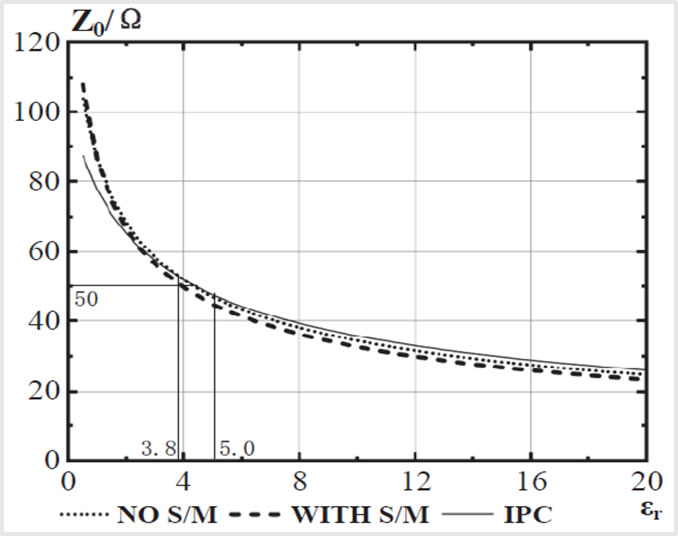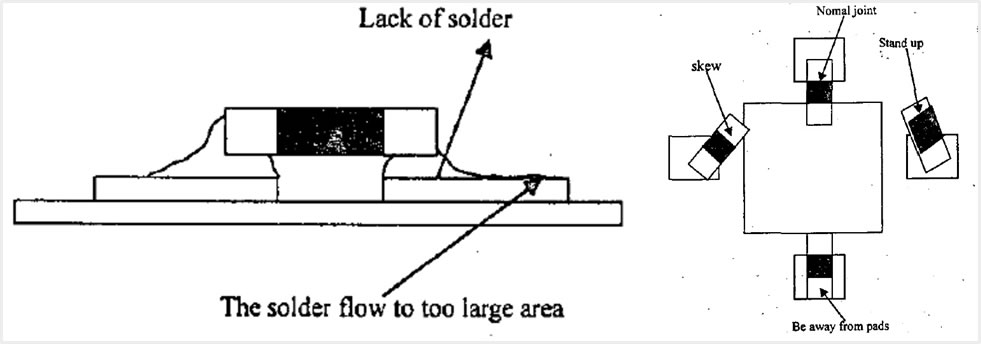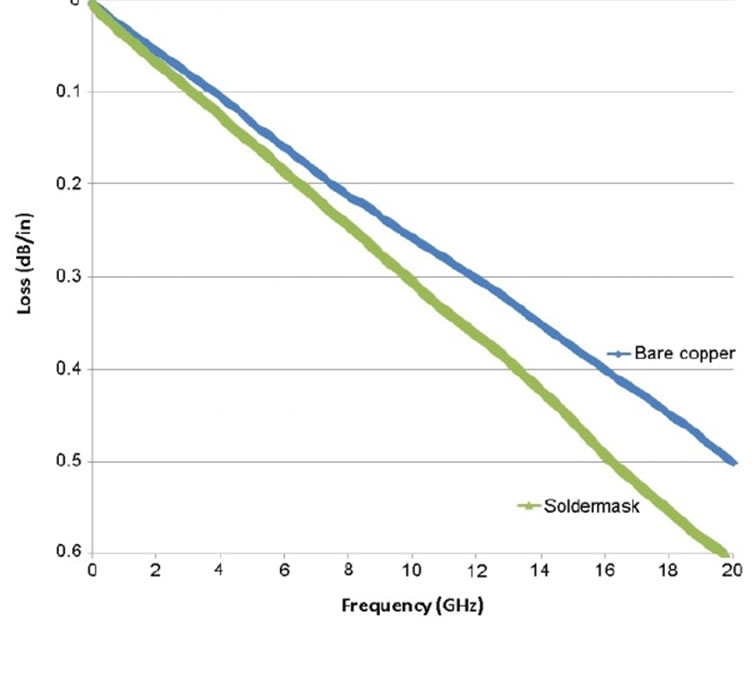With the rapid advancement in electronics technology, the dimensions of PCBs are shrinking whereas the signal rates are rising continuously. The twin demands require manufacturing high-density PCBs while ensuring very little to no signal integrity issues. The application of permanent solder masks on these high-speed and high-density PCBs may alter their dielectric properties, which can degrade the electrical performance of the high-frequency circuit. On the other hand, the lack of solder masks on PCBs will require a lot of reworking during the production phase due to the lack of solder in solder joints. To solve this dilemma, an alternative to the permanent solder mask is required that effectively does the job of the solder mask without degrading the electrical performance of the PCB traces.
This article discusses the adverse effects of using permanent solder masks on the signal integrity of high-frequency PCBs. It also highlights the use of an alternative, a temporary solder mask from Techspray that can simultaneously enhance signal integrity while avoiding PCB reworking.
Why Use Permanent Solder Mask (Overcoat, Solder Resist)?
Why are most PCBs green in color? Because almost all PCBs are coated with a layer of photoimageable polymer and solvent called solder mask. The application of solder masks has become a very common yet important practice during PCB assembling, especially in low-frequency PCBs. Some salient functions of solder mask include:
- Preventing signal copper traces from corrosion and other environmental conditions
- Preventing the shorting out of traces by excessive solder
- Preventing blockage of vias during automated soldering
- Temporary adhesive in the soldering of two-sided PCBs
During automated soldering processes like wave soldering, it is necessary to ensure that the vias stay open and are not covered by solder or flux. The solder mask effectively masks those vias thus providing them protection [1]. As the name indicates, the permanent solder mask becomes an integral part of the PCB and prevents the copper trace shorts afterward. Moreover, a solder mask ensures a sufficient amount of solder in solder joints which is necessary for reliable solder joints. The presence of a solder mask is known to increase the surface insulation resistance (SIR) of the circuit and reduces the probability of electrochemical migration (ECM) [2].
Why Avoid Permanent Solder Mask?
On the other hand, the use of solder masks in high-frequency PCBs (PCBs with PCI express or Ethernet signal traces) may introduce unwanted effects due to varying distributions of the electrical field. High-frequency RF traces (microstrips) are also vulnerable to these unwanted effects of crosstalk, reflection, and mismatch of impedance.
An important point to note here is that only those signal traces will be affected that are routed on the top or bottom layers of the PCB. If the high-frequency traces are routed in between the top and bottom layers, no unwanted effects will appear. This is attributed to the combination of high-frequency traces and solder masks on the top and bottom layers.
At high-signal frequencies, the signal traces act as transmission lines and the solder mask may affect the electrical field in those transmission lines [3]. With the change in electrical field distribution, the capacitance per length of the transmission line varies resulting in a change in the effective dielectric constant. The dielectric constant is known to increase in that case whereas the characteristic impedance (ideally 50 Ω for a uniform transmission line) and impedance continuity of the trace/transmission line decrease [3]. The results are shown in Figure 1.
According to a case study, the addition of an FR-4 solder mask (dielectric constant = 4.4 and dissipation factor = 0.02) increases the return loss and insertion loss of the transmission line, which adversely affects the performance of the trace/transmission line and gives rise to signal integrity issues [3]. In another study, the insertion loss for the microstrip was evaluated for two different cases (with and without solder mask) [4]. The result shown in Figure 3 clearly depicts that the addition of a solder mask increases the insertion loss.
Solving Signal Integrity Issues
From the perspective of high-frequency PCBs, the use of permanent solder masks is not justified as it creates signal integrity issues. Patches of permanent solder masks may be applied only where SMD components exist, however multiple patches will also deteriorate the signal integrity.
However, opting to assemble the PCB without a permanent solder mask may also cause troubles [5], as depicted in Figure 2. Some of these problems entail:
- Small amount of solder left in solder joints
- Soldered PCB components are skewed, and away from pads
- High probability of blocked vias after automated soldering
- Soldered PCB components stand up like tombstones
- Exposure of heat-sensitive components to higher temperatures during soldering

Figure 1: Dielectric constant vs characteristic impedance with and without solder masks [3]

Figure 2: SMD (Surface mount devices) components without solder mask [5]

Figure 3: Insertion loss with and without solder mask [4]
Temporary Solder Mask Reduce Dissipation Factor
Different solder masks may be evaluated to reduce the dissipation factor, return loss, and insertion loss of the PCB trace. A recent study proved that a low-loss solder mask with a dissipation factor of 0.01 can make a 10% improvement in the insertion loss as compared to the conventional solder mask having a dissipation factor of 0.025. However, it is still demanding to eliminate these losses [6].
This dilemma of reduced signal integrity in the presence of a permanent solder mask and the need for PCB reworking in the absence of a permanent solder mask can be completely resolved by applying a solder mask that can be removed from the PCB after PCB assembling. Needless to say, the solder mask will be there during the PCB assembly process and will be removed before the PCB is live. The utilization of some kind of temporary solder mask is the first idea that pops up in the reader’s mind and indeed, it is the right idea. Temporary solder masks do exist and unlike the permanent solder masks, they are readily soluble in organic solvents or water and can be easily removed from PCBs. The method of removal may be manual i.e., using tweezers or washing. The use of temporary solder masks in high-speed PCBs is documented [5].
More About Temporary Solder Mask
The temporary solder masks do not contain polyfunctional polymers and thus upon curing, they do not conjoin [5]. The temporary solder mask can be applied to the PCB in numerous ways:
- Stencil printing
- Silkscreen printing using aperture arrays
- Pneumatic dispensing
The curing method of the solder mask varies with the width of the solder mask coating and the curing time requirement. Exposing the solder mask to higher temperatures for longer times (reflow soldering) may cause bubbling or the mask may become brittle making it very difficult to remove. Some accepted methods for curing are:
- Heating using an air oven for 15-30 minutes at 140-150°F
- Heating using an air oven for 3-4 minutes at a maximum of 300°F
- Exposure to ultraviolet light for 5-45 seconds
Techspray Temporary Solder Masks
Be it PCB manufacturing, cleaning, or reworking, Techspray has been delivering quality products since 1968. Today, Techspray’s WonderMASK is the industry-leading temporary solder mask because of its quality and versatility.
The WonderMASK P Peelable Solder Mask is the non-ammoniated low-odor peelable temporary solder mask. Due to its non-ammoniated nature, it is perfectly compatible with gold and copper.
For the fastest cure times, WonderMASK PX Peelable Solder Mask is the ideal option. It is a hand-applied latex-based solder mask. With its homogenous curing, any thickness of the solder mask can now be deposited without worrying about the cure time. However, this product is not compatible with bare copper as it may cause discoloration.
Where peeling solder mask is not a viable option, Techspray also offers washable masks which can be removed in an aqueous inline batch wash systems. WonderMASK W Washable Solder Mask and WonderMASK WA Washable Solder Mask are water washable, low odor and nonflammable solder masks offered by Techspray.
All products from Techspray are nonflammable and RoHS compliant. With the use of Techspray’s Peelable and Washable Solder Mask, the PCB assembly process can be carried out without the need for reworking and the signal integrity issues associated with a permanent solder mask can be eliminated once the PCB is live. This can resolve the dilemma for PCB design engineers, making their lives easier.
References
|
[1] |
IPC, "silo.tips," June 2017. [Online]. Available: https://silo.tips/download/ipc-sm-840c-qualification-and-performance-of-permanent-solder-mask-ipc-sm-840c-a. [Accessed 17 June 2022]. |
|
[2] |
M. A. M. P. Xiaofei He, "Effects of Solder Mask on Electrochemical Migration of Tin-Lead and Lead-Free Boards," Materials Science, 2010. |
|
[3] |
Y. Chen, F. Ye, Q. Hu, L. Kang, S. Zhang and J. Chen, "Research on the Influence of Solder Mask on Signal Integrity in High Speed PCB," in 2021 IEEE 15th International Conference on Electronic Measurement & Instruments (ICEMI), Nanjing, China, 2021. |
|
[4] |
R. C. John Coonrod, "The Effects of PCB Fabrication on High-Frequency Electrical Performance," in IPC APEX EXPO. |
|
[5] |
L. Wei-cheng, "Application of temporary solder mask in SMT of high frequency circuit boards," in Fifth International Conference on Electronic Packaging Technology Proceedings, Shanghai, China, 2003. |
|
[6] |
J. Hsu, T. Su, X. Ye and C. Lin, "Microstrip signal integrity enhancement by using low-loss solder mask," in International Microsystems, Packaging, Assembly and Circuits Technology (IMPACT), Taipei, Taiwan, 2017. |





